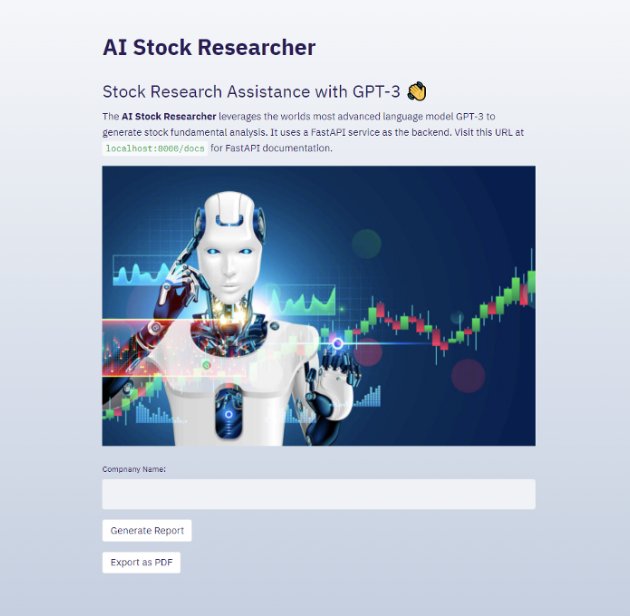20 Excellent Ways For Picking Invest Ai Websites
20 Excellent Ways For Picking Invest Ai Websites
Blog Article
Top 10 Tips To Evaluate Ai And Machine Learning Models For Ai Platform Analysis And Stock Prediction
In order to get accurate valuable, reliable and accurate insights You must test the AI models and machine learning (ML). Models that are not properly designed or overhyped can lead financial losses and incorrect forecasts. Here are 10 top tips for evaluating AI/ML models that are available on these platforms.
1. Understanding the model's purpose and method of operation
Clear objective: Determine whether the model was designed for short-term trading, longer-term investment, sentiment analysis or risk management.
Algorithm transparency: See if the platform provides information on the algorithms used (e.g. Regression, Decision Trees Neural Networks and Reinforcement Learning).
Customization. Determine whether the model is able to be modified according to your trading strategy or level of risk tolerance.
2. Evaluate the model's performance using by analyzing the metrics
Accuracy Verify the accuracy of the model's prediction. Don't solely rely on this measure, however, as it may be inaccurate.
Precision and recall: Assess the accuracy of the model to identify real positives, e.g. correctly predicted price changes.
Risk-adjusted gains: Examine if the predictions of the model lead to profitable transactions, after taking into account the risk.
3. Check the model's performance by backtesting it
Performance historical: Test the model with historical data and see how it would perform in the past market conditions.
Testing out-of-sample: Ensure that the model is tested on data that it wasn't trained on to avoid overfitting.
Analyzing scenarios: Evaluate the model's performance under different market conditions (e.g. bear markets, bull markets high volatility).
4. Check for Overfitting
Signs of overfitting: Search for models that do exceptionally well on training data but struggle with data that isn't seen.
Regularization techniques: Find out whether the platform is using techniques such as L1/L2 normalization or dropout to stop overfitting.
Cross-validation (cross-validation) Verify that your platform uses cross-validation for assessing the generalizability of the model.
5. Examine Feature Engineering
Relevant Features: Look to see if the model has meaningful features. (e.g. volume, technical indicators, price and sentiment data).
Selecting features: Ensure that the platform selects characteristics that have statistical significance. Also, do not include irrelevant or redundant information.
Updates to dynamic features: Make sure your model is up-to-date to reflect the latest characteristics and current market conditions.
6. Evaluate Model Explainability
Interpretation: Make sure the model provides clear explanations for its predictions (e.g., SHAP values, feature importance).
Black-box Models: Be wary when platforms employ complex models with no explanation tools (e.g. Deep Neural Networks).
User-friendly Insights: Verify that the platform offers useful information in a format that traders can easily understand and utilize.
7. Assess Model Adaptability
Changes in the market: Check if the model can adapt to new market conditions, such as economic shifts or black swans.
Verify that your system is updating its model on a regular basis with new information. This will increase the performance.
Feedback loops: Ensure that the platform is incorporating feedback from users or actual results to improve the model.
8. Be sure to look for Bias or Fairness
Data bias: Ensure that the data used for training is representative of the marketplace and free of biases.
Model bias: Determine if you are able to actively detect and reduce the biases in the forecasts of the model.
Fairness: Make sure whether the model favors or disfavor specific trade styles, stocks or even specific sectors.
9. Examine the Computational Effectiveness
Speed: See if you can make predictions using the model in real-time.
Scalability: Find out whether a platform is able to handle multiple users and large data sets without affecting performance.
Resource usage: Determine whether the model is using computational resources efficiently.
10. Review Transparency and Accountability
Model documentation: Make sure the platform has a detailed description of the model's structure as well as its training process, as well as limitations.
Third-party Audits: Check whether the model has been independently audited or validated by third organizations.
Error handling: Determine if the platform has mechanisms to detect and correct mistakes or errors in the model.
Bonus Tips
Reviews of users and Case studies User reviews and Case Studies: Read user feedback and case studies to assess the performance in real-world conditions.
Trial period: You can use the demo or trial version for free to test the model's predictions and the model's usability.
Customer Support: Verify that the platform has an extensive technical support or model-related support.
Follow these tips to assess AI and ML models for stock prediction and ensure they are trustworthy and transparent, as well as compatible with trading goals. Take a look at the recommended investing ai for website recommendations including trader ai review, investment ai, stocks ai, canadian ai stocks, trading ai bot, ai copyright trading bot, best ai stock, copyright financial advisor, copyright ai trading bot, trader ai review and more.
Top 10 Ways To Evaluate The Scalability Ai Stock Predicting/Analyzing Trading Platforms
Scalability is a crucial element in determining whether AI-driven platforms for stock forecasting and trading can cope with the increasing demand of users, volume of data and market complexity. These are the top 10 ways to determine the scalability of AI-driven stock prediction and trading platforms.
1. Evaluate Data Handling Capacity
Tip: Check if the platform is able to analyse and process large data sets (e.g., historic stock data, real-time market feeds, or other data sources like news and social media).
Reason: Scalable platforms are required to be able to handle growing volumes of data without performance degradation.
2. Check out real-time processing capabilities
Tips: Make sure you check the capability of the platform to handle real-time information streams, like live stock prices, or breaking news stories.
Why: The real-time analysis of your trading decisions is essential, as delays can lead to you missing out on opportunities.
3. Cloud Infrastructure Elasticity and Check
Tip: Check whether the platform is able to dynamically scale resources, and if it uses cloud infrastructure (e.g. AWS Cloud, Google Cloud, Azure).
The reason: Cloud platform elasticity allows the system's size to adapt based on use.
4. Algorithm Efficiency
TIP: Check the computational efficiency (e.g. deep learning or reinforcement-learning) of the AI models used for prediction.
Reason: Complex algorithms can be resource-intensive, and optimizing them is essential for scalability.
5. Learn about distributed computing and parallel processing
Make sure the platform is using distributed computing or parallel computing frameworks.
The reason: These technologies enable quicker data processing and analytics across many nodes.
Review API Integration, and Interoperability
Tips: Make sure to check the integration of the platform with external APIs.
The reason: seamless platform integration ensures it can adjust to new sources of data or trading environment.
7. Analyze User Load Handling
To test the effectiveness of your system, try simulated high-volume traffic.
Why: A scalable platform will provide performance even as the number of users increase.
8. Examine the model's retraining capabilities and adaptability
Tip: Evaluate how frequently and efficiently AI models are being trained with the help of new data.
Why: Models must constantly adjust to changing markets to ensure that they remain precise.
9. Check Fault Tolerance (Fault Tolerance) and Redundancy
Tips. Check that your platform is equipped with failover systems and redundancy for hardware orsoftware malfunctions.
Why is downtime so costly for trading. So fault tolerance is essential to scalability.
10. Monitor Cost Efficiency
Tips: Calculate the cost of the expansion of your platform. Consider cloud resources, storage for data and computational power.
Why: Scalability must not be at the expense of insufferable costs. Therefore, it is crucial to strike a balance between performance and cost.
Bonus tip Future-proofing
Be sure that the platform supports new technology (e.g. quantum computing or advanced NLP), and is able to adapt to changes in the regulatory environment.
By focusing your focus on these factors and focusing on these factors, you can evaluate the scale of AI prediction as well as trading platforms. This will ensure that they are durable, efficient, and also prepared for expansion. Read the top stock analysis websites examples for site info including ai stock trading, ai invest, ai trading platform, chatgpt copyright, chart analysis ai, trader ai app, best stock advisor, trader ai, ai stock, ai stock prediction and more.